Quck answer
Cats are low-maintenance pets but still require proper care to keep them healthy and happy. Here are some tips on how to care for a cat:
1. Provide a balanced diet with plenty of fresh water.
2. Regularly groom your cat to prevent matting and hairballs.
3. Keep your cat’s litter box clean to maintain good hygiene.
4. Schedule annual veterinary check-ups and keep up with vaccinations.
5. Provide toys and scratching posts to keep your cat mentally stimulated and physically active.
6. Keep your cat indoors to protect them from outdoor dangers.
7. Provide a cozy and comfortable sleeping area for your cat.
8. Show love and affection to your cat through playtime, cuddles, and positive reinforcement.
Pets

Discover the best ways to select the perfect cat for you, whether it’s an adult cat or a kitten and whether you should adopt from a shelter, breeder, or a friend.
You may have heard that cats are blessed with nine lives. While that may be up for debate, one thing is certain – your cat can enjoy a long and healthy life with proper attention and care. There are several aspects to consider when it comes to taking care of a cat, and we’ll be discussing all of them in the ensuing sections:
, there are many potential hazards that you need to be aware of. In this section, we will explore how to cat-proof your home to keep your furry friend safe. We will examine the areas of your home that are most dangerous for cats, such as the kitchen and bathroom. We will also provide tips on how to secure windows and doors, as well as how to keep your cat away from electrical cords and other potential dangers.
Even if you’ve gone many years without any accidents with your cat, danger could still be present in your home. This section will cover potential hazards that are disguised as common household objects and provide tips on how to make your home safe for your feline friend. It also includes information on safe and dangerous cat toys, finding the right veterinarian for your cat, and the importance of vaccinations. Before getting a cat, it’s important to consider factors such as age, breed, and personality to ensure that the cat is a good fit for your lifestyle. While kittens are adorable, they require a lot of work and will quickly grow into adult cats that can live for over a decade.
If you have the time, space, and energy, getting a kitten is a wonderful experience. However, keep in mind that taking care of a kitten requires a lot of attention and routine veterinary care such as booster shots, worming, and spaying or neutering. While most kittens are initially affectionate and passive, they need socialization and training to maintain these qualities as they grow up. Additionally, it’s important to note that young children and young kittens may not mix well.
With an abundance of cats in the United States, choosing the right one can be a daunting task. While each cat is unique, sources such as friends, neighbors, shelters, and breeders can help you make an informed decision. Getting a cat from a friend or neighbor can be convenient, but keep in mind that they may not have received extensive veterinary care. It’s also important to be cautious about mixing business with friendship.

В©2006 Publications International, Ltd. Adopting a cat from a shelter not only provides you with a great companion, but it also saves a life.
Every year, millions of homeless cats are euthanized in animal shelters. Adopting a cat from a shelter can save its life, make space for another cat, and provide you with a pet that has already received low-cost shots and neutering. However, be prepared to go through applications and interviews, and check the facilities and the condition of the cats available for adoption. Pet Finders (www.petfinder.org) can provide a list of cats available for adoption from local shelters.
If you want a purebred cat, then purchasing from a reputable breeder is the best option. Good breeders have extensive knowledge about cats and their breeds, and they are careful about who they sell their cats to. However, beware of “bargain” purebreds or breeders who breed strictly for profit. Reputable breeders maintain high-quality animals, keep careful records, and produce only one or two litters per breeding female per year. You can ask for a breeder referral from national breed associations such as the Cat Fanciers’ Association (www.cfa.org).
Stray cats can also make great pets. You don’t have to worry about finding the right cat; sometimes, the right cat finds you. Taking in a stray cat doesn’t involve adoption interviews or fees, and you might be saving a life. However, you’ll need to cover the cost of shots, worming, neutering, and other health issues that may arise. Sometimes, local humane societies or animal hospitals may offer reduced rates for treating a foundling cat, but this is not guaranteed.
Another important decision to make when choosing a cat is whether to have an indoor or outdoor pet. Learn about the pros and cons of each choice in the next section.
Choosing Between an Indoor or Outdoor Cat
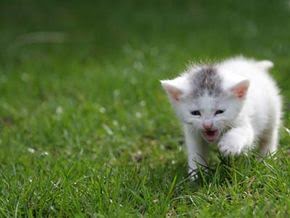
В©2006 Publications International, Ltd. There are advantages and disadvantages to letting your cat roam outside.
Many cat owners believe that their cats won’t be truly happy unless they can go outdoors. However, is it really necessary for cats to go outside like dogs? Even if cats want to go outside, is it really in their best interest?
Do Cats Need to Go Outside Like Dogs?
The primary reason dogs are taken for a walk is for elimination, followed closely by exercise. Dogs are pack hunters and have a natural instinct to run for long periods. However, only small dogs can get enough exercise indoors. Cats, on the other hand, are ambush hunters and rely on short bursts of fast running. They also have an instinct to bury waste, which is why they use litter boxes. Therefore, there is no pressing reason to take a cat outside. While fresh air and sunshine are good for cats, it is unclear if the outdoor life is more “natural” for them. Once cats were domesticated, they had to adapt to new circumstances, such as the bitter cold of a Midwestern winter, dogs, wild animals, and speeding cars and trucks. Therefore, the only reliable way to keep a cat safe is to keep them indoors. While the outdoors may seem appealing with nature’s beauty, there are also vicious animals, cruel people, traffic, disease, and animal control officers who may impound a cat if they step off the owner’s property. Even country cats are not necessarily safer outside than city cats. Therefore, it is best to keep a cat indoors to ensure their safety.
Some serious and deadly illnesses that affect cats require contact with infected felines or areas where they spend a lot of time. Feline immunodeficiency virus (FIV), which weakens the cat’s immune system, is mainly spread through bites from infected cats. Feline leukemia virus (FeLV) usually needs extended close contact with an infected cat, such as sharing litter boxes or food and water bowls, or mutual grooming. The risks of disease are low for indoor cats but significantly higher for outdoor or indoor/outdoor cats. Cat owners, particularly those with young children, should be aware that outdoor cats are more likely to pick up diseases and parasites that can affect humans, from minor problems such as fleas to more serious illnesses such as Lyme tick disease and even rabies.
It is not necessary for cats to roam free outside to enjoy fresh air and sunshine. Even though it is safer for cats to live indoors, it is possible to take them out on a leash and harness (not a collar) to get some exercise. However, not all cats will enjoy walking on a leash, and there is still a risk of picking up fleas or encountering unleashed cats and dogs.
Building a cat run is not as difficult as it may sound. The run should be enclosed on all sides, including the top, and securely anchored. The screens should be of the heaviest grade of outdoor mesh, and the walls should extend a few inches below the ground to deter cats from digging their way out. It is important to provide a heated, waterproof shelter for the cat to retreat to in case of bad weather. Having a roof in the cat run or other outdoor enclosure is essential as cats are excellent climbers and leapers, and even an eight- to ten-foot wall may not hold them. The roof and walls of the run provide another kind of security by keeping other animals, people, and things out, which the cat may not be able to escape from.
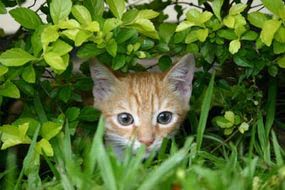
В©2006 Publications International, Ltd. Outdoor cats pose safety risks.
Cats that roam freely outside often engage in noisy fights with other cats, damage neighbors’ plants by chewing or digging them up, kill local birds (though they may also help control rodents), and use other people’s gardens as litter boxes. While some people and cat owners may consider these issues minor annoyances, others view them as serious problems. If your cat gets into a fight, the scratches on its face or back may not be too concerning, but bite wounds that close up quickly can trap dirt and germs, leading to painful abscesses. Additionally, bites during fights are a common way for feline immunodeficiency virus to spread. Free-roaming, unaltered cats also contribute to pet overpopulation, which fills animal shelters to capacity and results in the euthanasia of millions of dogs and cats each year.
Once you’ve found the perfect cat for you, it’s crucial to learn how to properly care for it. The next section will cover tips for feeding your cat.
Cat Feeding Tips
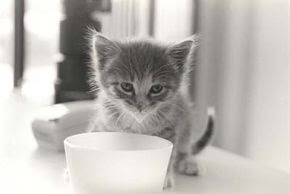
В©2006 Publications International, Ltd. Proper nutrition is crucial for your cat’s health.
“You are what you eat” is a popular saying that’s just as applicable to cats as it is to humans. Feeding your cat a high-quality diet can help ensure it stays healthy.
The pet food industry generates billions of dollars each year, with over 100 million dogs and cats living in American homes and countless others in shelters, catteries, and kennels. Additionally, thousands of people feed stray cats. Considering that a single cat can consume over 90 pounds of food per year, the cost of feeding cats is staggering.
Just like with human food, there are some treats that are healthy for cats and others that are essentially junk food. While the occasional indulgence won’t cause any harm, it’s best to avoid making unhealthy snacks a regular part of your cat’s diet.
Can Cats Be Vegetarians?
The wild ancestors of domestic cats were hunters, and this instinct remains in modern cats. Whether your cat is pouncing on a piece of lint or bringing you gifts of dead birds and mice, it’s expressing its natural desire to hunt and kill prey. A quick look at your cat’s teeth will confirm that they’re not designed for eating plants like alfalfa sprouts.
Your cat is a true carnivore and cannot survive on a vegetarian diet. Animal proteins contain specific nutrients that are necessary for your cat’s health, such as taurine, which is essential for preventing blindness and heart problems. Additionally, cats require vitamin A and arachidonic acid found only in animal tissue. Therefore, it is crucial never to feed your cat dog food as it lacks the essential nutrients that your cat needs. Even though it may be cheaper, it can cost your cat her health, sight, or life.
Feeding your cat raw meat or relying on hunting is not a viable solution either. Cats have not lived in the wild for hundreds of years; hence their hunting skills have deteriorated, making them vulnerable to diseases. Moreover, some of these diseases can get passed on to humans.
Cats also have a tendency to eat plants, especially if they are green and grow from the ground. This can be worrying if the plants are poisonous or your prized houseplants. However, this behavior is instinctive, and you cannot stop it. Instead, you can create a “cat garden” with oat grass or catnip, which are good choices for your cat to munch on. Ensure that the container holding the garden is sturdy and cannot tip easily.
To keep your plants safe from your cat, try placing them in areas that are out of reach or behind cat-proof barriers. Hanging plants from the ceiling or placing them in locations that your cat cannot climb or jump to can also work. If you cannot move your plants, try creating a shield around them with chicken wire, plant markers, or even mothballs. However, these barriers may not be visually appealing. Spraying bitters on the leaves or adding Spanish moss around the base of the plant can also deter your cat from chewing on them. It is important to keep in mind that adding bad-tasting substances to the plant may harm it.
Cats do not need snacks between meals if they are well-fed. Giving your cat too many snacks can lead to unhealthy weight gain and an imbalanced diet. It is okay to give your cat a treat now and then, as long as they are not overweight and are eating the recommended amount of quality cat food daily. Store-bought cat treats tend to lack good nutrition and are meant to taste good. Giving your cat people food is not a big problem, but it is essential to keep nutritional balance in mind. Cat owners should be cautious when feeding their pets dairy products as they may not digest them well and could get sick. People food can provide healthy snacks for cats, such as scrambled eggs or pasta, but it is crucial to ensure that the cat is getting the right nutrients in the right amounts.
Plenty of Water is Essential for Your Cat’s Health
It is important for your cat to consume about an ounce of water for every pound of body weight daily. This means that an average-sized cat needs two quarts of water every week. Apart from drinking water, the food your cat eats is also a vital source of water. Foods that contain more water reduce the amount of water your cat needs to drink. Canned cat food contains up to 75 percent water, making it more expensive than dry cat food. Dry cat food, on the other hand, contains only about 10 percent water, which means a cat that consumes only dry food has to drink a lot more water.
Dehydration is a serious problem for all living creatures, especially cats. While a cat can survive without food for days and lose up to 40 percent of its body weight, a loss of body water of only 10 to 15 percent can be fatal. Although milk is a good source of water, it’s important to ensure that your cat has plenty of clean and fresh water available at all times.
In the next section, we will discuss store-bought cat food versus homemade cat food.
Store-Bought Cat Food vs. Homemade Cat Food
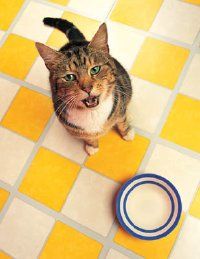
В©2006 Publications International, Ltd. At least 26 percents of an adult cat’s diet should be protein.
While homemade meals give you the opportunity to choose what your cat eats, it’s best to let the experts – major pet food manufacturers – prepare the bulk of your cat’s diet. Determining the right amounts and balance of foods can be challenging. Food can be divided into three categories of nutrition: protein, fat, and carbohydrate, and different animals require different proportions of these nutrients. Additionally, nutritional needs change over time, and kittens have different nutritional needs than adult and senior cats. Most pet food companies have special formulas for various age and activity levels, and there are prescription diets for cats with different health conditions.
When it comes to feeding our feline friends, there are various options to choose from. While some cats may come running at the sound of a can opener, it doesn’t necessarily mean that canned food is better than dry food. Both types of food have their advantages and disadvantages, but the most important factor is whether the food meets your cat’s nutritional needs. Your budget and your cat’s preferences also play a role in determining which type of food to choose. There are three general forms of store-bought cat food: dry, canned, and semimoist. Dry cat food, also known as kibble, can be stored for a long time, has no smell, and can be left out all day. Canned food has a pungent smell and is a little bit messy to handle, but it is tempting to even the pickiest eaters. Semimoist food combines the convenience of dry food with the tastiness of canned food, but it may contain nonfood fillers and dyes. Each type of food has its strong points and weak points. It’s important to note that all brand-name cat food covers the basic nutritional needs of an average cat. However, if you’re concerned about the overall quality of the food, you may want to consider premium-brand foods, which are usually found in pet stores or through veterinarians. While feeding your cat store-bought food ensures that they’re getting the nutrients they need, it’s okay to supplement their diet with home-cooked food as long as it’s appropriate for cats. Organ meats and dairy products should be given to cats in moderation, as too much of these foods can cause health problems. In the next section, we will discuss the importance of grooming your cat.
Cat food is an essential part of a cat’s diet, and it is important for careful consumers to read the labels to understand what they are feeding their pets. Cheaper brands may have the same nutrients as premium cat food, but the quality of the ingredients and the cat’s ability to digest them are what really matters. Specialty pet food companies do extensive research into pet nutrition and use quality ingredients to ensure that the cat is getting the necessary nutrients. Although it may cost more, it is worth it to invest in a brand-name or specialty pet food.
Grooming is also an important aspect of cat care, and owners should take an active role in helping their cats maintain their coats. Long-haired cats require more grooming than short-haired cats since their coats are more prone to forming mats. Mats can be painful and uncomfortable for the cat and may even require shaving if they become too severe. Shorthair cats still require regular grooming to maintain a healthy coat, but their shorter, coarser outer coat is easier to manage. Regular grooming is necessary for both longhair and shorthair cats to keep them looking and feeling their best.
Cats groom themselves by using their tongue and teeth, but this can result in them swallowing hair. The more hair they swallow, the higher the risk of hairballs forming in their stomach and intestines. While coughing up hairballs is the least dangerous side effect, excessive hair consumption can block the intestines and require surgery to save the cat’s life. To avoid this, it is recommended to invest in grooming tools and use them regularly.
For longhair cats, regular grooming is essential, and while professional groomers offer training, skill, and experience, it is still important to have grooming tools at home. Bad mats and tangles can be dealt with at home, but extreme situations are best left to the professionals. Even if you become skilled at using grooming tools, it is still advisable to visit a professional groomer occasionally.
Every cat owner should have a metal comb and slicker brush for basic grooming. Flea combs are also useful for outdoor cats or in flea-prone areas. Grooming mitts can make the process more comfortable for your cat. When grooming at home, it is important to be gentle and patient and to pay attention to any tangles or mats.
To make grooming enjoyable for your cat, start by using gentle strokes and petting. It’s good social behavior and can lead to long periods of blissful grooming between cats that get along well. However, be sure to use restraint and not force your cat into uncomfortable positions or grooming strokes. If your cat resists, take a break and try again another day. Consider seeking professional help if your cat has bad mats or tangles. Additionally, clipping your cat’s nails can be done with ordinary human nail clippers. It’s best to start when they’re kittens and also play with their paws and toes for fun.
Read More
Tips for Bathing Your Cat
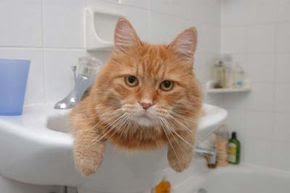
В©2006 Publications International, Ltd. While you do not need to bathe your cat often, it can be a challenge when you do.
With the exception of removing mats or performing a medical procedure, there is typically no reason to shave a cat’s hair. Cats are naturally designed to have a full coat of hair, and removing it can cause issues with their body temperature regulation and expose their usually protected skin. You can trim a long-haired cat’s coat for appearance and to prevent tangles, but it’s best to have a professional groomer do it.
Bathing a cat is also not usually necessary, as they are good at keeping themselves clean. However, there are times when a bath is required to treat or control fleas, clean up after an adventurous cat, treat a skin condition, or remove a noxious or dangerous substance from their fur. If you’re inexperienced or unsure, it’s best to have a veterinarian or groomer handle mandatory baths. But for those who want to try it at home, here are some basic tips.
Be prepared. Have all of your bathing supplies ready ahead of time. You will need a good pet shampoo (medicated shampoos for fleas or skin conditions should be obtained from your vet, not over-the-counter), a large fluffy towel, a brush and comb, and either a handheld showerhead or plastic tumbler for wetting and rinsing. If possible, comb out your cat’s hair before bathing, especially for long-haired cats. If you know how, trim your cat’s nails before the bath. (Note: You can protect your cat’s eyes during the bath with a neutral ophthalmic ointment available from your veterinarian.)
Get your bathing station ready. Use a large sink with a dish sprayer attachment or a bathtub. Start the water before you put the cat in, and make sure it’s not too hot or too cold. A comfortable temperature for your hands should work fine. You will get wet, covered in suds, and possibly scratched by an upset, wet cat, so wear clothes that can get dirty yet protect you from scratches.
Prepare before adding the cat. Bathing a cat often requires two people – one to hold the cat and one to bathe – but you can do it alone. Practice your restraint techniques on dry land before the bath. Firmly but gently grasp your cat at the base of the neck or on the scruff with one hand, pressing down slightly. See how well you can reach different parts of your cat’s body with your other hand. Figure out when and how to change grips during the bath. Establish your bathing routine step-by-step before the cat is in the sink or tub; otherwise, your cat may try to escape in your moment of hesitation or confusion.
Start washing. Wet your cat, starting at the head and working your way to the tail. Apply shampoo in the same way, lather, and rinse thoroughly. (Read the label carefully on medicated shampoos. Some require 5 to 15 minutes before rinsing to be effective.) It’s important to rinse thoroughly. Soap residue can irritate your cat’s skin or be swallowed when they lick their fur. Rinsing also helps eliminate fleas and other parasites that are immobilized but not killed by the bath.
To dry a cat, gently squeeze out any excess water from their fur and wrap them up in a fluffy towel. If your cat is willing, you can comb out any tangles, but if not, wait until they have dried off. Some cats may tolerate a blow dryer, but be cautious as many are scared by the sound and feel of it. It’s best to test their reaction on a non-bath day to avoid traumatizing them. Keeping your cat healthy involves removing potential dangers from their environment. The next page provides tips on how to cat-proof your home.
To prevent accidents, it’s essential to be cautious with your cat’s curiosity. Drapery, blind, and electrical cords can be dangerous, and cats are more likely to get tangled or chew on them due to their inquisitive nature. To ensure maximum safety, tie or wrap all cords out of feline reach. Electrical cords should ideally be run under rugs or behind furniture, and plastic conduit can be used if they have to be near cats. Occasionally, a cat may still try to chew on cords, but applying a bitter-tasting substance or using positive reinforcement can help change their behavior.
We purchase cleaning products not only to clean but also to disinfect and make our homes smell nice. Unfortunately, some of these products can be harmful to cats. Pine-based cleaners and those containing phenol, such as Lysol disinfectant, are toxic to cats and should not be used in pet areas, sleeping quarters, or litter boxes. Ethylene glycol, found in antifreeze, is also dangerous since it tastes sweet and is often fatal if ingested. It is important to clean up any spills immediately and to keep products containing ethylene glycol out of reach of pets and children. Plants can also be poisonous to cats. While most cats will eat grass or plants to purge themselves, some plants can have serious effects. These include apricot pits, azalea, buttercup, caladium, calla lily, castorbean, cherry, chrysanthemums, crocus, daffodil, daphne berries, holly, hydrangea, iris, ivy, lily of the valley, mistletoe, mushrooms, narcissus bulbs, oak, oleander, peach pits, philodendron, poison ivy, potatoes, privet, rhubarb leaves, rosary pea, star of Bethlehem, string-of-pearls, sumac, and sweet pea. Dieffenbachia, also known as dumb cane, is a common houseplant that can paralyze a cat’s mouth if ingested. It is important to keep anything that is toxic to you or a child out of reach of your cat.
Poinsettias, also known as Christmas flowers, are part of the nightshade family which is notorious in literature and fact for being deadly. Although poinsettias were thought to be highly toxic to cats and dogs, a recent study showed that they do not make cats any sicker than other nonpoisonous plants. However, it is always safest to keep cats away from all houseplants to be sure.
During warmer weather, many cats are affected by “high-rise syndrome,” which refers to the collection of injuries resulting from a fall from a high window. Although some cats have survived falls from several floors up, the majority do not. To prevent these falls, all windows that are opened must have secure screens made of heavy-duty grade hardware cloth to withstand the weight of a cat. Screens should be regularly inspected for wear and tear, especially in cold-weather areas.
Some cat owners believe that letting their cats out on their balconies is a safe way to give them fresh air and sunshine. However, many cats have fallen over railings while chasing after birds or moths, even with a leash or tether. It is crucial to supervise cats on balconies and ensure their safety at all times.
While buying toys for cats is a good way to keep them entertained, it is essential to choose safe toys. In the next section, we will discuss what toys are safe for cats.
In case of a cat poisoning emergency, the ASPCA National Animal Poison Control Center or Animal Poison Hotline, operated by the University of Illinois College of Veterinary Medicine, can be contacted at 1 (888) 426-4435. A $55 flat fee can be charged to a credit card to receive assistance. For more information, contact the ASPCA Animal Poison Control Center located in Urbana, Illinois.
Read More
Choosing Safe Toys for Your Cat
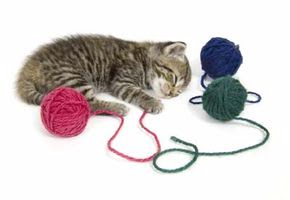
В©2006 Publications International, Ltd. Yarn can be harmful to cats and cause serious medical issues.
Playing with toys is an important part of a cat’s life, but it’s crucial to choose safe ones. Yarn and string, for example, can be hazardous and cause blockages in a cat’s digestive tract. Even supervised play with string or yarn is risky since the cat can become tangled up and panic, leading to injury or even death. It’s also essential to keep items like sewing thread and dental floss out of a cat’s reach as they can cause damage to the cat’s mouth, stomach, and intestines.
Cats will play with anything small enough to bat across the floor, including paper clips, foil, and rubber bands. However, these items can be easily swallowed and cause choking or more severe issues. Candy wrappers are also dangerous since cats find them irresistible, and the sugary residue can coat their stomach lining, blocking the uptake of nutrients from food.
When choosing a safe cat toy, it’s essential to look for something sturdy that can withstand being thrown, gnawed, clawed, and pounced on without breaking apart. Catnip-filled toys can encourage play, but they can also be eaten by the cat if they’re made from light fabric or felt. It’s also crucial to avoid toys with small or removable parts that can come off and be swallowed, leading to harmful consequences.
Let’s talk about something fun. A toy is not really a toy if your cat does not play with it. Cat owners often feel disappointed and frustrated when their expensive custom cat toys go unused while their cats choose to play with a crumpled paper or a simple table tennis ball instead. Cats love games that involve their natural instincts such as climbing, running, leaping, stalking, and pouncing. Choosing toys that encourage these behaviors will definitely make your cat use them. For instance, a table tennis ball will roll and hop away when your cat pounces on it, encouraging chasing and batting. Since cats see moving edges better than stationary objects, toys that wiggle, bob, or weave fascinate them and trigger their hunting reflexes.
The final section of this article will cover the most important aspect of caring for your pet – finding a good veterinarian. Finding a good vet for your cat is just as important as finding a good doctor for yourself.
Veterinarian Visits and Vaccinations
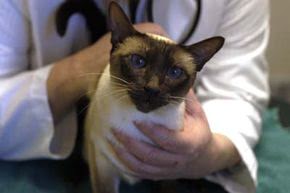
В©2006 Publications International, Ltd. It is important to find a vet who makes both you and your cat comfortable.
Choosing a veterinarian for your cat is similar to choosing a doctor for yourself. You want someone with a good bedside manner whom you like and trust. If you have special needs, you also want a doctor who understands and takes those needs into consideration.
Finding a Vet
If you are a first-time cat owner, have recently moved to a new area, or need to find a new veterinarian, you can try looking up “Animal Hospitals” in the Yellow Pages. All veterinarians attend school for as many years as medical doctors and must meet strict licensing standards, so you are bound to find a competent and professional vet that way. However, the relationship between you, your pet, and your vet will last for many years, so it makes sense to find the right vet. This may be an area where city dwellers have an advantage over rural residents. A small town may have only one vet, while a big city may have dozens within a few miles.
In addition to the Yellow Pages, here are some other resources for finding a good veterinarian:
Contact professional organizations. The American Veterinary Medical Association (www.avma.org) can refer you to affiliated veterinarians in your area, and the American Animal Hospital Association (www.aahanet.org) can direct you to clinics that meet its standards. The AVMA can also help you find feline specialists, behavior experts, veterinary eye doctors, and other professionals. However, expect to pay higher fees for specialists.
Ask other “cat people” for recommendations. Friends, family, and neighbors who own cats usually have veterinarians they trust. Take advantage of their experience and ask for recommendations.
Precautions to Take Before Choosing a Veterinarian
When you receive a recommendation for a veterinarian, it is important to call and schedule a brief visit to the clinic to meet the staff and tour the facilities. While it is important to be mindful and discerning, keep in mind that the vet and clinic staff may be busy attending to other patients. In the event that you have a lot of questions or require the vet’s undivided attention, it is recommended to schedule an appointment and offer to pay for it.
Here are a few items to consider when visiting the veterinary clinic:
- Prioritize your needs and wants in a veterinarian and a veterinary hospital, whether it is affordable pricing, advanced medical techniques and equipment, or a vet’s bedside manner.
- Inquire about the clinic’s hours of operation, after-hours services, and emergency care availability.
- Learn about the variety of services offered at the clinic, including routine check-ups, surgeries, and boarding, and the fees associated with each.
- Ensure that you feel comfortable with the support staff, as their attentiveness and friendliness will reassure you that your pet is receiving the best possible care.
Feline Vaccinations: Understanding How They Work
Vaccinations are designed to protect cats from common viral diseases by introducing a noncontagious version of the virus to the cat’s immune system. This triggers the cat’s disease-fighting immune system, which destroys the virus, providing immunity to the cat from the dangerous, contagious version of the virus. However, vaccines cannot cure diseases caused by viruses and are not always 100 percent effective. There are some viral diseases, such as FIV, where the vaccine is ineffective because it cannot combat viruses that shut down the immune system upon entering the cat’s body. In such cases, the vaccine cannot perform its intended function.
To keep your cat healthy, it is important to get its shots from a veterinarian or animal hospital. The minimum requirement for a cat is to have its rabies shot and distemper-combination vaccine up-to-date. The combination shot protects against feline distemper and common upper respiratory diseases that cause flu-like symptoms in cats. The vaccines can be given through an injection under the skin or in the muscle or as an aerosol through the cat’s nostrils.
For a cat receiving its first vaccine, it usually requires a series of shots spaced several weeks apart. Kittens should start receiving shots at seven or eight weeks of age until they reach four months old. Rabies vaccines are given to kittens over three months and adults. The American Association of Feline Practitioners recommends subsequent boosters for many diseases a year from the initial series and then every three years. Consult your vet for vaccine scheduling recommendations for your cat.
Vaccines for other cat diseases have been available since the mid-1980s, including feline leukemia virus (FeLV). FeLV attacks a cat’s white blood cells and can lead to cancer. Although most cats exposed to FeLV don’t get sick, infected cats can still pass the virus on to other cats. The FeLV vaccine may not be necessary for a cat that is never exposed to FeLV-infected cats. A blood test can determine if your cat is infected. If not, keeping your FeLV-free cats indoors and away from FeLV-infected cats is probably all the protection they need. For cats that test positive for FeLV, vaccines won’t help.
Feline immunodeficiency virus (FIV) and feline infectious peritonitis (FIP) are also fatal cat diseases caused by viruses. Vaccines exist for FIV and FIP, but their effectiveness in preventing disease transmission is still under debate. Consult your vet to determine if your cat is at risk for these diseases and if the potential benefits of each vaccine outweigh the risks.
As a pet owner, it is important to ensure your cat is happy and healthy. Vaccinations are a crucial part of keeping your feline friend healthy, so consult with your veterinarian about your cat’s vaccination schedule.
FAQ
1. What are the basic needs of a cat?
A cat needs food, water, a litter box, a scratching post, and a comfortable place to sleep. It’s important to provide your cat with nutritious food that meets their dietary needs. Fresh water should be available at all times. A litter box should be kept clean and in a quiet area. A scratching post is important to satisfy your cat’s natural urge to scratch and stretch. A comfortable bed will provide your cat with a safe and warm place to rest.
2. How often should I feed my cat?
Cats generally need to be fed twice a day, but it depends on the age and activity level of your cat. Kittens need to be fed more often, while older cats may only need to be fed once a day. It’s important to follow the feeding instructions on the cat food packaging and not to overfeed your cat. Obesity can lead to health problems in cats.
3. How often should I groom my cat?
Cats are generally good at grooming themselves, but they may need some help from their owners. Brushing your cat regularly will help to remove loose hair and prevent hairballs. Long-haired cats may need to be brushed more often than short-haired cats. Cats should also have their nails trimmed every few weeks to prevent them from becoming too long and causing discomfort.
4. How can I keep my cat healthy?
Regular visits to the vet are important to keep your cat healthy. Cats should receive vaccinations, be checked for parasites, and have their overall health monitored. It’s also important to provide your cat with a balanced diet, regular exercise, and a clean and stress-free environment.
5. How can I train my cat?
Cats can be trained to do a variety of things, such as using the litter box, coming when called, and not scratching furniture. Positive reinforcement is the best way to train a cat. Treats and praise can be used to reward good behavior. It’s important to be patient and consistent when training your cat.
6. How can I keep my cat safe?
Cats should be kept indoors to protect them from outdoor hazards, such as cars and other animals. If your cat is allowed outside, make sure they are supervised and have a safe and secure area to roam. Cats should also be microchipped and wear a collar with identification tags.
7. What should I do if my cat gets sick?
If your cat shows signs of illness, such as vomiting, diarrhea, or lethargy, you should take them to the vet right away. Cats can be good at hiding their symptoms, so it’s important to be aware of any changes in behavior or appearance. Regular check-ups with the vet can also help to catch any health problems early on.





Leave a Reply